Beneath Its Spell
Click Here to Play Podcast
From No Outspan
by Deneys Reitz
During the first few months of 1926 I attended Parliament in Cape Town, where our Nationalist opponents accused us of being imperialists and traitors to the True Cause, and we charged them with racialism and with exploiting Afrikaans sentiment for vote-catching purposes.
This sort of thing has gone on since 1912, and will no doubt continue for another generation or two until we realise the futility of it all.
In spite of our wrangles, I was on terms of personal friendship with some of our enemies, chief of whom was my successor, the new Minister of Lands, Mr Piet Grobler. He was a relative of the late Paul Kruger and he was a gentleman of the old school, liked by everyone regardless of party cleavages.
I lost no opportunity of attacking his government and his party, but, in spite of this, he asked me one morning to undertake an investigation into the question of the ‘bontebok’, a rare antelope that was almost extinct.
Mr Grobler was interested in the protection of wild life in South Africa, and on the strength of my previous efforts in the Sabi country, he wished me to look into the matter. I gladly accepted the task. I was furnished with a car and a couple of officials, so leaving Parliament to its talking, we set out at once.
The bontebok (Damaliscus Pygargus) are large, white-faced, white-bellied antelopes with chocolate-coloured backs and flanks, and they carry lyre-shaped horns. In former years they roamed the coastal belt of the Cape Province in countless thousands, but they were by now so reduced in number as to be very near vanishing point.
In the face of the wanton slaughter of our game that has gone on for more than two centuries, it is fortunate that so far only the quagga (a species of zebra) has become extinct, and neither money nor tears will bring him back to life again; now we were threatened with the loss of an even more interesting type.
This was largely due to indiscriminate hunting, but also to the fact that the bontebok die out if they have to share their grazing with domestic stock; and of late years, sheep farmers had increasingly invaded their ancestral haunts.
With my two companions I made a survey of the position. We examined the long strip of country that lies between Cape Agulhas and Algoa Bay, for in this area alone were a few of them said still to survive. It was hard work over the hills and dales of the south, and after careful search we found that, all told, there were less than seventy bontebok left in South Africa, and therefore in the world, so narrow had the margin of safety become. These were running in small groups mostly in the neighbourhood of Cape Agulhas (the southernmost point of Africa) and it was clear that if immediate steps were not taken, they would soon join the quagga in oblivion.
In the end I was able to find a suitable tract of land in the district of Bredasdorp. We had it enclosed by an eight-foot wire fence and, enlisting the help of neighbouring farmers, sixteen bontebok were, with difficulty, shepherded through a V-shaped approach and driven into the sanctuary. Today the rest of the bontebok have gone, but from those sixteen animals a herd of over two hundred has been bred up, and the continued existence of Damaliscus Pygargus is assured.
When I returned to Parliament I was glad to find that Mr Grobler had introduced a Bill to turn the Sabi into a statutory game reserve, to be called the Kruger National Park. Under his Act a Board of Trustees was established, and I was appointed one of their number.
This was a handsome gesture and while it in no way diminished my antipathy to the Nationalist government, I was sincerely pleased – for it opened a new vista.
From now onward I was enabled to journey to the Low Country at frequent intervals, and more and more I was to come beneath its spell.
Next →
← Previous





